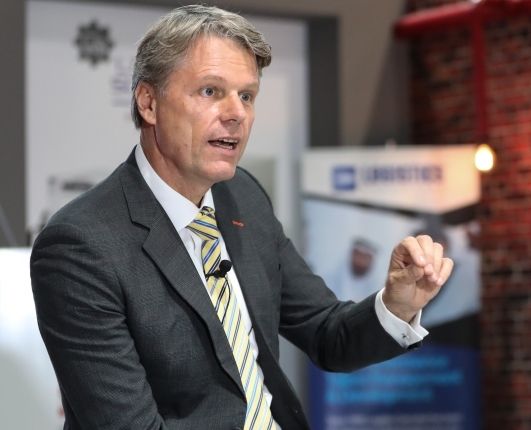
GCC’S Food Imports to Double to US$53.1 Billion by 2020
The GCC’s food import bill will double over the next few years to a value of US $53.1 billion, says a MEED Insight Thought Leadership Report released today.
The report, sponsored by Oman’s SOHAR Port & Freezone, was released at Gulfood Manufacturing, the third and largest showing of the Middle East’s biggest food manufacturing, processing and packaging, logistics and materials handling exhibition, which is running at the Dubai World Trade Centre (DWTC) until Wednesday night (November 9).
The Middle East Food Sector 2016 report says prevailing climatic conditions in the GCC, which currently produces only 30 per cent of its food requirements and imports the remaining 70 per cent worth over US $150 billion annually, will keep it dependent on food imports for the foreseeable future.
“Because of climatic conditions and scarce water resources, farming activities are limited and the GCC will remain dependent on food imports well into the future,” says Mark Geilenkirchen, Chief Exectuive Officer, SOHAR Port and Freezone.
Such is the import demand that SOHAR Port and Freezone has recently made the food sector its fourth pillar for investor recruitment. The trading hub says it is now progressing the construction of a US$170 million state-of-the-art Food Zone, combining the region’s first dedicated agro terminal with flour and sugar mills, as well as infrastructure for downstream food manufacturing and processing industries.
“The food sector is also core to diversification efforts as regional governments recognise its employment generation capabilities, import cost reduction, and re-export potential,” adds Geilenkirchen.
The report identifies food as the GCC’s highest consumer spend segment and predicts it will rise a further five per cent to reach US$106 billion by next year. However, it also says high urbanisation rates will affect spending patterns – identifying growing demand for convenience, frozen and packaged food. It says the Middle East will play a role in developing a global frozen food market forecast to reach US $293.7 million by 2019.
The report says that by 2018, the GCC will see significant growth in organic farming, food retailing and its f&b service segment predicting that within two years the region’s organic farming market is expected to be worth US$1.5 billion; its food retail market will grow to US$155 billion and its overall f&b segment to US$13.2 billion.
Food consumption in the GCC stood at 39 million metric tonnes (MT) in 2014 and is expected to rise at a CAGR of 4.5 per cent until 2019, according to the report: “An expanding population base is a key driver of the rise in food consumption. The population of the GCC region is expected to reach about 57 million in 2020, registering an annual CAGR or 1.8 per cent over 2014-2020. Increasing tourist inflow into the region could also stimulate food consumption, particularly of packaged foods and restaurant meals.”
The report also identifies cereals, such as rice, wheat, barley and maize as the region’s most in-demand food products, accounting for 55 per cent of total food demand. It does, however, also pinpoint increasing demand for meat, particularly halal beef. “The rise in per capital consumption of meat indicates a shift in dietary preference towards meat consumption. The demand for foreign halal beef has grown steadily. By 2019, the UAE will be among the world’s top 10 nations in per capita consumption of meat,” says the report.
Changing country-by-country consumption trends are also outlined with Saudi Arabia and the UAE still being the region’s top consumers. “Home to over 75 per cent of the GCC’s population, Saudi Arabia and the UAE are the largest food consumption centres. While Saudi Arabia accounts for the highest consumption, primary owing to its large population based, the UAE’s share in overall food consumption has decreased, while consumption in Kuwait and Qatar has increased considerably.”
Qatar, says the report, is proving to be fastest-growing food consumer up from 2012-2017 with an average annual growth of five per cent - almost double the GCC average. The growth is attributed to the rapidly rising population in the country owing to its mega events, such as the 2022 FIFA World Cup, which have increased the inflow of foreign workers mainly in the construction sector.
The report also gives strong insights into the region’s logistics and distribution system for the food sector, with growth predicted in investment in warehousing to improve operational efficiency and processes and cold storage infrastructure.
“The report makes for essential reading for all involved in the f&b eco-system from production, to storage, distribution and retail,” said Mark Napier, Exhibition Director – Gulfood Manufacturing, DWTC. “Its overall conclusions show an economic segment which is on a huge growth trajectory in the region but one which is being transformed by increasing attention to operational and cost efficiency and changing consumption trends. The DWTC shows covering the f&b sector, including Gulf Manufacturing, are weathervanes to sector changes which are picking up speed annually as competition within the market and within overseas suppliers becomes more intense.”
Gulfood Manufacturing 2016 features exhibitors from 50 countries including 29 official national pavilions representing production machinery leaders Austria, Germany, Italy, Korea, Spain, Switzerland, Taiwan and the United Kingdom. The show has also welcomed first-time pavilions representing Indonesia, Ireland, Russia and South Africa.
DWTC has rolled out its most extensive Hosted Buyer Programme for the show which is sponsored by Tetra Pak. More than 2,000 of the region’s most prominent industrial buyers have been invited to the event and supported with complimentary flights, accommodation and transport to and from the show.
Gulfood Manufacturing will be open between 10am – 6pm on November 8 and 10am – 5pm on November 9. Attendance, which is free-of-charge, is for trade professionals only. For more information, please visit: gulfoodmanufacturing.com.


























